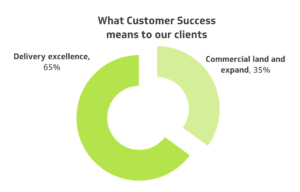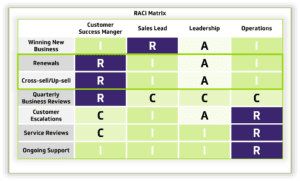by Matthew Best, Senior Consultant
In our recent webinar on Success in Customer Success, we asked the SBR community what they thought Customer Success meant. 65% of them felt that CS was still more delivery focused than commercially focused. I wonder what the split would have been if I asked that question 10 years ago? I would guess that it would be an even larger swing toward a delivery focus. So what has changed and where is it going?

At the recent Industry event, the panel discussion focused on the role of CS in the SaaS industry, discussing future ideas such as expanding existing customer bases, bringing in a more commercial focus for CS, and targeting managers with increasing margin and cost management into their KPIs.
One member of the panel said that they’re doubling down on expanding their existing customer base and bringing in a more commercial focus for CS, targeting managers with increasing margin and cost management into their KPIs.
At SBR, we’d agree that a Businesses Account or Customer Success team should have a degree of Customer Growth focus and target expansion and growth of existing customers, alongside retention and ultimately success.
Fundamental to enabling your team starts with balancing the operational load on your team with the commercial / growth focus that you want them to have.
What I mean by that is, how much operational/manual work does your CS team need to do to support essential account management activities, and what percentage of their overall capacity is this?
In a SaaS context, that operational/manual work could include the creation of Service Review documents from scratch, or support ticket escalation burden.
So, freeing up our CSMs from extended Support tasks or manual report creation, allows us to mobilise them toward growth.
Below are some of the ways that you might achieve this within your organisation:
- In a previous blog, I talked about ‘The Value of Customer Success’ and getting crystal clear on your Customer Journey – map it out, with responsibility matrixes, and share it with your team.
- Never build a Customer Journey in isolation from your team. At SBR we co-create playbooks, customer journeys, and guides with our clients, and their teams, to bring them on the journey; it helps enablement and adoption.
- Remove the noise from your CS team – take the clear Customer Journey that we talked about in blog one and use it to clearly articulate everyone’s responsibility, avoiding CS picking up the ‘slack’.
- Make it the responsibility of a Support team to own Issue and Incident management, front to back. Many organisations pass the incident coordination effort to their CSMs; consuming their time in a space where there is little value to the client or the business.
- Make it the job of your sales team to focus on new logos and acquisition, allowing your CS team to focus on renewals and growth within existing accounts, clearly dividing responsibilities between the functions.

CSMs, in my experience, demonstrates a fine balance between care for your customers, interest in your service, and a desire to grow and develop the business and themselves. They are perfectly positioned for growth, through their connection to your customers and your customer’s challenges, they are best placed to achieve growth in this way.
Becoming a trusted advisor is key to account development and growth. Who better to take on that role than your Customer Success Managers?
What changes will you make to your CS team’s goals and KPIs in 2023 to grow your business? Get in touch by emailing info@sbrconsulting.com or call us on +44 (0) 207 653 3740.
You can sign up to receive regular updates and join over 4,000 others who enjoy access to our unique research insights, expert guidance, and advice.